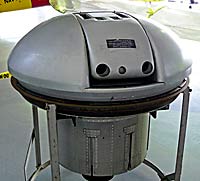| page 1 of 2 |
| US Air Force Museum - WWII - BOCKSCAR Boeing B-29 Superfortress
Bill Maloney 1/20/2007 |
| page 1 of 2 |
Boeing B-29 Superfortress Specifications:
 |
Although this particular B-29 is stripped of its dorsal and ventral turrets, you can find a B-29 Gun Turret at the Mid Atlantic Air Museum in Reading, PA |
Length: 99 feet
Wingspan: 141 feet 3 inches
Height: 29 feet 7 inches
Crew: 10
Weight: 70,140 empty, 124,000 maximum take off
Max Speed: 358 miles per hour
Cruise Speed: 230 miles per hour
Range: 3,200 miles
Service Ceiling: 31,850 feet
Fuel Capacity: 9,363 gallons of 100/130 octane avgas
Armament:
Eight .50 cal Browning machine guns in 4 remotely controlled electrically powered turrets
Two .50 cal Browning machine guns and one 20mm Oerlikon cannon in the tail turret
20,000 pound bomb load
This particular B-29 carried one weapon, the Atomic Bomb Fat Man
Power Plant: Four 2,200 horsepower Wright Cyclone R-3350 twin row radial engines driving 16.5 foot Hamilton Standard four bladed props
First Flight : September 21, 1942
Cost: $639,000
This Boeing B-29 Superfortress is the plane which dropped the Fat Man Atomic Bomb over Nagasaki ending WWII.
Initially the B-29 Superfortresses were very prone to mechanical failures. The B-29 R-3350 28 cylinder radial engines used Magnesium crank cases and super charger housings. The first problem was a tendency to backfire through the carburetor setting the leaky fuel system afire. When the magnesium got hot enough from the gasoline fire, the magnesium would begin to burn on its own and the on board fire suppression system could not put it out (magnesium burns very intensely). The problem with diagnosing this fault was that the magnesium fire made identification of the cause impossible, as the magnesium parts burned to ashes Finally they had a partial fire that they were able to put out just as the magnesium was starting to burn and figured it out. From there Wright went to fuel injection and that problem was solved.
However there was still another problem. The magnesium crank cases expanded differently from the other engine parts as they heated up and caused oil leaks, again setting the engines on fire after the oil ran out or they blew apart. The "Solution" was to have a crewman at each blister continuously watching the wings and engine nacelles for signs of oil leakage. When the leak was seen the engine was shut down and the mission aborted. Wright never changed the crank case material of the R-3350 throughout the life of the aircraft.
If anyone reading this page was a vet or civilian that had anything to do with the Manhattan Project or dropping the first two atomic bombs, I have one thing to say to you:
Thank You!
My father served as an electrician's mate on the Destroyer Escort USS Bangust in the Pacific doing anti aircraft picket duty during the most important invasions in the Pacific in WWII. Japan's Kamikaze operations were becoming very effective and off Okinawa alone over 1000 Kamikaze planes sunk more than 30 American ships. A Destroyer Escort serving in the outer ring of picket duty was one of the first ships those pilots saw. While the pilots were instructed to seek out the carriers and other larger vessels they didn't always do so. The planes they were given were obsolete or damaged and repaired and had only enough fuel to reach the fleet with a little extra loiter time. If they encountered mechanical problems or were very low on fuel, rather than possibly wasting their attack they dived into the first vessel they saw, including PT Boats. Some were too young and inexperienced to know the difference between a Destroyer Escort and a Cruiser.
If the United States had not dropped the atomic bomb on Hiroshima and Nagasaki and America had to invade the Japanese homeland, my father would have been on the front defensive line to these attacks. There would have been a very good chance that I might not be here today to create these web pages.
Another nicely restored Boeing B-29 Superfortress can be found at the New England Air Museum in Hartford CT.
Here is a link to the B-29 video "The Last Bomb" . It has great WWII period footage of a B-29 raid over the Pacific to Japan.